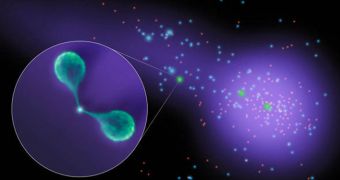Some galactic clusters in the Universe appear to be connected to each other via sandbar-like structures called filaments which are made out of gas and dust. In a new study, researchers were able to gain more insight into these formations, by studying a peculiar galaxy.
The unusual cosmic object allowed astronomers to get new insight into the function that these filaments have in creating the cosmic web, which is a lattice-like scaffolding permeating the Cosmos.
Using data from the NASA Spitzer Space Telescope, as well as from other observatories, experts were able to look at the galaxy in more detail than ever before, which ultimately allowed them to study it thoroughly.
What is most interesting about these sandbars is that they connect galactic clusters, which are basically large agglomerations of galaxies concentrated in a small area of the Universe.
About two years ago, the infrared sensors on Spitzer managed to find a large filament connecting the Abell 1763 and Abell 1770 galactic clusters together. Because of their nature, sandbars are very hard to study.
One of the most interesting thing about the 2008 discover was that the observed filament contained a large number of galaxies that were forming new stars at a frantic pace.
The new investigation was basically a follow-up study on the past research, which took astronomers even deeper into the filament. Inside, they discovered a very weird galaxy, Space reports.
The object has a boomerang-like shapes, which is very uncommon for galaxies, as well as interesting light emissions. It is now believed that the main reason why the structure has this shape is gas passing through it.
The hot material apparently distorts the galaxy as it passes through the filament connecting the two galactic clusters. These data may help experts determine the particle density of the sandbars.
But the finding also carries an additional implications as well. It could be that many distorted galaxies in the Universe, which lie outside filaments, may be influenced by faint threads of previously-undetected matter passing through
“These filaments are integral to the evolution of galaxy clusters – among the biggest gravitationally bound objects in the Universe – as well as the creation of new generations of stars,” explains researcher Louise Edwards.
She holds an appointment as a postdoctoral investigator at the California Institute of Technology (Caltech) in Pasadena. Edwards is also the lead author of a research paper on the issue, which appears in the December 1 issue of the esteemed Astrophysical Journal Letters.

 14 DAY TRIAL //
14 DAY TRIAL //